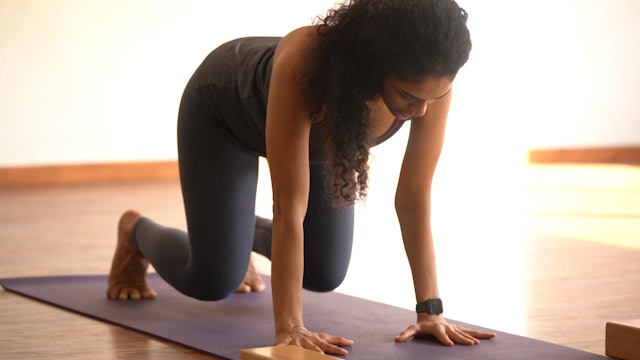Playlist 8
The first set of Adavus are almost complete. The students must be well practiced enough to assimilate a Korwe. Please note the Adavus are serving as revision and not intended for the absolute beginner. An absolute beginner will not be able to practise a Korwe without finishing and practising Adavus for a minimum of two years.
-
Warm up : Isolations
The warm up changes in length and content as your body changes. What a conditioned body needs to warm up is very different than a body that is beginning this journey. This warm up is safe and helps a dancer at every level to find openness in the body. It can be done in combination with the hip op...
-
Legs and Core 2
This 25 minute workout, concentrates on your legs and core muscles. It is part of the initial series of instructed videos that have verbal cues at every step. Please pause if you need to, and take a break where necessary. It has a very small portion that has explosive movements. There is an optio...
-
Paraval Adavu 1
Paraval literally means to spread. Some schools of thought also call the Paraval adavu, the 'Pakkadavu' as it moves to the side while sliding. Some others change the name based on the way the foot articulates with the floor. A few of the types of Paraval, can be referred to as Marditam adavau, as...
-
Paraval Adavu 2
Paraval literally means to spread. Some schools of thought also call the Paraval adavu, the 'Pakkadavu' as it moves to the side while sliding. Some others change the name based on the way the foot articulates with the floor. A few of the types of Paraval, can be referred to as Marditam adavau, as...
-
Kuditta Thattadavu
This Adavu is referred to as the "Ta tai ta ha adavu" by some people. It is also called the Yegar Thattadavu. 'Yegar' and 'Kuditta', both mean jump. There is a small jump/ snatch onto the balls of the feet and then a strike. The first series will address the basic Kuditta tattaduvu. The many vari...
-
Kudiita Thattaduvu
Pointers for Kuditta Thattadavu:
Try to go down instead of hopping up each time you snatch onto your heels.
Keep dropping your tailbone and pushing your thighs back.
When you bend to the side, elongate your lower side, so the length of your top side and bottom side remain the same.
Do not push... -
Jaar Adavu/ Sarikal Adavu
The adavus in this category span a variety of feet articulations. The slide sometime occurs on the whole bottom of the foot. Sometimes in the ball of the foot, and other times on the heel, depending on the choice of the choreographer. These adavus can also vary greatly in levels and leg positions...
-
Jaar Adavu/ Sarikal Adavu 2
'Jaaru', literally means, to slide. This is also called the Sarikal Adavu. In the RK Method, we refer to the standing series that end in Samapada as the Jaar Adavu series and the other sliding Adavus that use Muzhumandi, and Aalidam as Sarikal adavus for simplicity.
This Adavu incorporates the ...
-
Sarvalaghu Jathi 1
This Jathi has an instructional video. The counts for all the Sarvalaghu Jathis are all in 4 counts. Please watch and try to learn the Jathi for practice.
Please keep in mind that the Raadha Kalpa method likes to reinforce the idea of neutrality in Nritta patterns that are not placed within a c...
-
Sarvalaghu Jathi 2
This Jathi does not have an instructional video. The counts for all the Sarvalaghu Jathis are all in 4 counts primarily. There are small variations in this particular Jathi. Please watch the Tala Theory video after you learn the Jathi and try to analyse where the variations occur.
Please keep ...
-
Adi Tala Korwe 1: Instructions
Please watch the first three lectures on Talam before beginning the Korwe series. You can practice to the Korwe video , once you have learned it with instructions. Pay attention to the counts and try to count in your mind continuously.
A Korwe is a set of adavus that are formatted to a specific...
-
Adi Tala Korwe 1
Please watch the first three lectures on Talam before beginning the Korwe series. There is an instruction video for each Korwe.
A Korwe is a set of adavus that are formatted to a specific rhythmic structure, ending with a Muktayam/Teermanam adavu and layered on a Swara like in a Jatiswaram or Ta...













